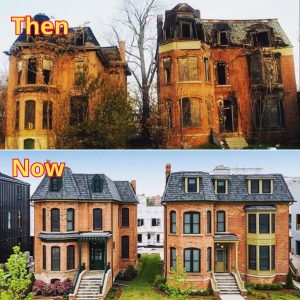
Nestled in the serene landscapes of Michigan, a collection of abandoned houses built between 1874 and 1877 have recently undergone remarkable restoration, transforming them from neglected relics into stunning examples of historical preservation. These houses, once the epitome of 19th-century architecture, had fallen into disrepair over the decades. However, their recent restoration has breathed new life into these forgotten structures, allowing them to once again stand as proud symbols of Michigan’s rich history.
The Original Charm
In their heyday, these houses were marvels of Victorian architecture, showcasing intricate woodwork, ornate facades, and elegant interiors. Built during a time of economic prosperity, they were homes to affluent families who enjoyed the comforts and luxuries of the period. The craftsmanship and attention to detail in these houses were a testament to the skill and artistry of the builders of that era.
The Period of Neglect
As time passed, economic downturns, changes in ownership, and shifts in population led to the gradual abandonment of these once-grand houses. Overgrown gardens, crumbling walls, and broken windows became common sights, and the houses were left to the mercy of the elements. Vandals and nature took their toll, and these structures, which once symbolized prosperity, became haunting reminders of a bygone era.
The Restoration Effort
In recent years, a concerted effort by preservationists, historians, and local communities has aimed to restore these houses to their former glory. The restoration process was meticulous, involving the careful removal of decades of decay and the painstaking recreation of original architectural details. Skilled craftsmen were employed to ensure that the restoration stayed true to the houses’ original designs, while modern amenities were discreetly integrated to provide comfort without compromising historical integrity.
A New Lease on Life
Today, these restored houses stand as vibrant testimonies to Michigan’s architectural heritage. They have been repurposed as museums, community centers, and even private residences, attracting tourists and history enthusiasts from far and wide. The restoration has not only preserved the physical structures but has also rekindled interest in the region’s history, inspiring further preservation efforts and fostering a sense of pride within the local community.
Conclusion
The journey of these Michigan houses from abandonment to restoration is a story of resilience and dedication. It highlights the importance of preserving historical structures and the value they bring to contemporary society. Through these efforts, the spirit of the 19th century continues to live on, allowing future generations to appreciate and learn from the architectural and cultural legacy of the past.





